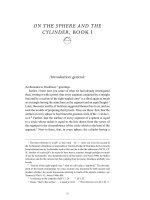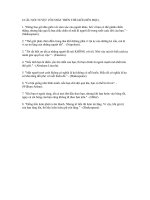I quit SUgar with the luchbox book
Bạn đang xem bản rút gọn của tài liệu. Xem và tải ngay bản đầy đủ của tài liệu tại đây (11.28 MB, 104 trang )
contents
Introduction
What does a healthy lunch look like?
What about snacks?
What about kids?
You eat leftovers a lot for lunch…what’s the trick?
How to use this book
Recipes
5 Inside Out Breads
Totable Mugs and Jars
A Bunch of Salad Jars
Little Lunch
Big Lunch
Sunday Cookup
Soups for All Seasons
A Bonus Office Cake
introduction
At the I Quit Sugar office each day, lunch is a focal point for us all. We are lucky
enough to have a big office kitchen where we gather to assemble our “desk
lunches”. All kinds of ingenious ideas for toting, heating, dressing and adding
pizazz are on display. The team even have Friday cook-offs (follow them on
Instagram!). Consider this book that you hold here a “best of” these ideas,
compiled from a number of my previous print-only books.
Me, I rarely (if ever!) buy lunch out. My midday meal is mostly an opportunity to
ensure I get a big nutritious hit in the middle of the day. And probably not a week
goes by when I’m not asked how I go about doing this, by both busy office workers
and parents. How about we share with you my answers… and some recipes!
Yours in wellness,
Don’t forget to share your creations and tips on social media, tagging us so then
we can share… and on and on goes the love! #IQSlunchbox #IQSJERF
What does a healthy lunch look
like?
At I Quit Sugar we work to the bold aim of getting seven to nine serves of
vegetables and fruit into everyone’s diets each day (the Australian guidelines
recommend six serves; the UK just five).
So lunch should contain about three serves of veg!
Plus a portion of protein.
Add a serve of good fat (your good fats guide is here)… about 1 tablespoon of
extra-virgin olive oil, butter, coconut oil or ¼ cup of cheese or avocado, for
instance. This might come in the form of a dressing.
Most of the wonderful essential vitamins, minerals and amino acids in
our food are fat-soluble only. Without fat, you’re not getting the full
bang for your nutritional buck!
eating full meals
I believe most people do not eat enough – at least enough dense nutrition –
particularly at lunch. I was the same for years. I’d get all modest with my midday
meal, then turn to snacks (sweet ones) around 3pm. It took several visits to Europe
to get a good feel for how a meal should be eaten. Over there, women and men
alike commit to a proper lunch that fills them up until dinner. They don’t do
afternoon tea and snacks are not de rigueur.
Some things to try:
Eat a handful-sized serve of protein at breakfast, lunch and dinner.
Include at least 2 cups of vegetables at lunch and dinner. If it’s a salad, it should be 3
cups.
While adjusting to this ‘three meals only’ way of eating, add an extra boiled egg (or two)
or feta cheese (a proper slab) to your meal if you get hungry. Throw on some seeds, nuts
and, of course, a good glug of extra-virgin olive oil or dressing like the Europeans do.
Don’t be shy about including several elements. I’ll often eat a soup or broth and a box
of leftover roast vegetables with a leftover chop.
What about snacks?
The research that backed this approach pertained to diabetics. You could say it’s
a myth borne as a paltry fix for sugar addiction. But most of us were not designed
to eat this way – it’s inefficient and taxing on our bodies, which don’t get the
opportunity to rest between meals. An increasing number of studies are showing
that bigger breaks between meals have big health benefits.
Plus, there’s this:
Full meals tend to be nutritionally dense; snacks rarely.
The good news: Once you’re off sugar for several months, you’ll find you don’t need
to snack.
curbing the snack attacks
Most of the time when I think I’m hungry between meals it’s more a case of my not
being quite satiated... yet. In such cases I find it helpful to:
Wait 15–20 minutes. Sometimes my metabolism is slow to react. Wait a little – go for
a walk, run an errand – and then see if you’re still hungry.
Drink some water. Quite often hunger is actually thirst.
Eat a tablespoon of coconut oil. This works 100 per cent and for a good few hours.
Promise!
If I’m genuinely hungry between meals, I eat. I recommend nuts, cheese or
yoghurt. They can be found most places (even in service stations) and they work fast.
Cinnamon and all things nice
Why do I add cinnamon to my ‘sweet’ recipes? Along with turmeric, cloves and bay
leaves, it stimulates insulin activity (indeed, triples it) and helps process sugar
more efficiently.
Sitting at a café in Paris recently, I heard an old man next to me comment on a
couple walking past eating pizza on sagging paper plates. “Pfft, they are obviously
not European,” he said. The French (and most Europeans) don’t eat on the run, It’s
seen as déclassé (a promenade stroll with a gelato or glace is the exception). I see
it as unhealthful. Full meals are packed with nutrition and satiate. On-the-run food
is junky and leaves us wanting more. The lack of mindfulness and commitment
also means we’re not aware of what and how much we’re eating. Again, no
satiation.
what about kids?
Although we don’t think adults need to snack, kids are a different story. Their little
bodies need as much fuel as possible for all that growing they need to do. Check
out our section on little lunch for some great snack ideas to keep little tummies full
between main meals.
My kids have a no peanut rule at their school…
cool?
Yup. We’ve marked all nut-free recipes as “Kid-friendly”.
You eat leftovers a lot for
lunch…what’s the trick?
On the 8-Week Program we guide people to simply cook double and bang half in a
lunchbox for the next day. You can then eat the meal cold (with some fresh salad
greens added) or reheated (maybe with an extra serve of Par-cooked ‘n’ Frozen
Veggies the next day.
If I want to get fancy (using the office stovetop) I do my Last Night’s Dinner with an
Egg Stuck In It routine. I share the recipe for this a little later.
Also see my rant about doggie bags from restaurants and cafes, and how they’re
not illegal (should your waiter try to tell you as such)!
How do you make it work in an office kitchen? Like
how do you actually carry it all in and heat it?
It goes like this…
We do salad jars. Follow our tips on the right ordering of ingredients to make it all
work when you tip into a bowl!
We use microwavable BPA-free containers.
We tote things frozen… they defrost by lunchtime.
Note: Defrost things slowly, in the fridge, if you can, or in a cool spot. It will prevent
denaturing.
We’re cool with microwaves. If the only thing standing between you
and a healthy meal is a microwave, use it!
But ensure you don’t heat foods in plastic containers. Transfer to a bowl and place
a plate on top to cover.
We bring extra bits – herbs, ferments etc in ziplock bags to jazz everything up at
the last minute.
We always reuse our ziplocks. Just wash in soapy water, turn them inside out and
stick them to the kitchen window to dry. Genius!
What basics do you suggest I have in my fridge,
freezer and pantry?
In our freezer we always have Par-cooked ‘n’ Frozen Veggies, peas, loaves of
homemade bread, pumpkin puree and shredded chicken to use as bases for lunch
meals, making cooking time even quicker.
In our freezer we also keep a bunch of things in ice cube trays: Dressings, stock for
deglazing Last Night’s Dinner.
In our pantry we always have a few tins of sardines, tuna, good quality extra-virgin
olive oil and eggs (to toss into a pan of leftovers or into muggins).
In our fridge we always have one or two ferments, good quality butter and jars of
homemade dressings and stocks, the base of all great lunches.
On our kitchen counter, we keep spring onions in a glass of water, ready to snip
into a salad or on top of leftovers for a fresh punch.
But now to the recipes…enjoy!
how to use this book
You’ll notice every recipe has a bunch of icons next to it. Here’s what they mean:
This stuff suits most FODMAPs, Paleo peeps, vegans, lactose intolerants, nut sensitives,
gluten-frees and anyone in between or beyond.
2 cups buckwheat groats
¼ cup chia seeds
1½ teaspoons gluten-free baking powder
1 cup grated sweet potato
¼ cup coconut oil
1 onion, chopped (if you’re on FODMAP,
use 2 tablespoons chopped chives or
the green tops of green shallots and add
½ cup extra sweet potato)
1 teaspoon sea salt
¼ cup sunflower seeds
Rinse the buckwheat well. Place in a large bowl or jar and cover amply with water.
Allow to soak for at least 4 hours (preferably overnight).
Preheat the oven to 160°C and line a 23cm × 13cm loaf tin with baking paper.
Place the chia seeds in a glass jar with 1 cup of water. Seal with the lid and shake
every few minutes until a chia gel forms (about 10 minutes).
Drain the buckwheat using a sieve – it might be slimy, so ensure you rinse it well.
Allow all the water to drain out.
Place the drained buckwheat, chia gel, baking powder, sweet potato, coconut oil,
onion and salt in a food processor or high-powered blender and process until a
thick paste forms. Spoon into the prepared loaf tin and sprinkle the sunflower
seeds on top.
Place the bread on the middle shelf of the oven and cook for 1 hour. When cooled,
remove from the loaf tin and allow to cool completely before cutting into 1cm
slices. Serve as is, or toasted and spread with coconut oil (or butter or olive oil,
depending on your dietary needs).
This bread will last 4–5 days in the fridge. To freeze, cut into slightly thicker
(1.5cm) slices and layer between baking paper. It can be thawed and toasted very
successfully.
This bread is great on your guts and wonderfully balanced to keep your doshas calibrated.
I’ve also sprouted the beans to reduce the phytic acid and make it even gentler on the guts –
not a big deal if you don’t have time, but it creates a more textured bread, so consider doing
so. Why is it ‘inside-out’? Well, I’ve taken my standard kitcheri recipe ( from my second
book) and put the toppers (the egg and coriander) and the sweet potato variation all on the
inside of the bread to bring you a meal in one loaf.
1 tablespoon ghee or coconut oil, plus
extra to serve (optional)
1 small red onion, finely chopped
1 teaspoon each of black mustard seeds,
cumin seeds and fennel seeds
1 teaspoon each ground coriander seeds
and ground turmeric
1 tablespoon grated ginger
1½ cups sprouted mung beans or brown
lentils
1 cup cooked basmati rice
1 cup grated sweet potato
1 cup arrowroot
1 teaspoon baking powder
1 teaspoon sea salt
3 eggs
¼ cup ground chia seeds
shredded coconut, to garnish
cream cheese, to serve
Preheat the oven to 180°C. Grease and line a 23cm × 13cm loaf tin with baking
paper.
Melt the ghee or coconut oil in a small frying pan over a medium–high heat. Add
the onion and sauté for 1–2 minutes. Add the mustard, cumin and fennel seeds,
spices and ginger, and sauté for 1–2 minutes until the mustard seeds start to pop
and the onion is translucent. Set aside to cool.
Transfer the onion to a food processor with the sprouts, rice, sweet potato,
arrowroot, baking powder, salt, eggs and chia seeds and process until combined.
Pour into the prepared tin and smooth the top of the batter. Sprinkle with
shredded coconut. Bake for 1 hour or until a skewer inserted in the middle comes
out clean. Leave to sit for 5 minutes before transferring to a wire rack. Once the
loaf is completely cool, cut into thick slices and store in a container (or wrapped in
foil) in the fridge. It will keep for up to 5 days. Alternatively, slice and freeze for up
to 1 month.
Serve the kitcheri loaf warm, spread with cream cheese, coconut oil or butter.
Yep, a vegetarian baked dinner in a loaf with added bits to make it a dish worthy of a
celebration.
5 cups chopped raw veggies
1 onion, chopped
4 cloves garlic, skin on
3 eggs
1 teaspoon chopped rosemary
1 tablespoon chopped thyme plus extra
sprigs to garnish (optional)
good pinch of sea salt
2 tablespoons flour (any kind)
2 tablespoons coconut oil, melted
1 cup chopped pistachios
mushroom sauce
3 knobs of butter
pinch each of sea salt and freshly
ground black pepper
150g button mushrooms, sliced
½ cup cream
Preheat the oven to 200ºC and line a baking tray and a loaf tin (23cm × 13cm)
with baking paper.
Place the vegetables and garlic on the baking tray and roast for 30 minutes.
Transfer to a food processor (squeeze the garlic out of its skin first) and pulse until
the vegetables resemble breadcrumbs. Add the eggs, herbs and salt and blend
until combined, leaving some chunks. Stir through the flour, coconut oil and
pistachios.
Pour the mixture into the lined loaf tin and bake for 40–50 minutes until a skewer
inserted into the centre of the loaf comes out clean. (Remove from the oven after
25 minutes and press the extra thyme sprigs into the top of the loaf, if you like.)
Set aside to cool a little.
To make the mushroom sauce, place the butter, salt, pepper and mushrooms in a
skillet over a low heat. Cook the mushrooms for 10 minutes until softened, then
stir in cream. Reduce the sauce until the desired consistency is reached.
Lift the loaf from the tin and slice into thick slices. Serve with the the mushroom
sauce.
This simple loaf sees the outside sandwich toppers embedded in the bread.
A meal-in-one in every slice.
1 1/2 cups almond meal
3/4 cup arrowroot flour
1/2 teaspoon sea salt
1/2 teaspoon bicarbonate of soda
5 eggs
1 1/2 teaspoons apple cider vinegar
1 tablespoon finely chopped flat-leaf
parsley
1/3 cup pitted olives, halved
3/4 cup grated zucchini
1/3 cup finely diced ham
1/2 cup finely grated Parmesan cheese
2 tablespoons pepitas
Preheat the oven to 160°C and line a loaf tin with baking paper.
In a large bowl, mix together the almond meal, arrowroot flour, salt and
bicarbonate of soda. In a separate bowl and using a fork, whisk the eggs lightly
with the apple cider vinegar. Add the parsley, olives, zucchini, ham and cheese
and whisk well, then add the egg mix to the dry ingredients. Mix well to combine,
then pour the dough into the prepared loaf tin and sprinkle with the pepitas.
Bake the bread for 30–35 minutes or until the top starts to turn golden and a
skewer comes out clean. Remove from the oven and transfer to a wire rack. Allow
to cool for 5 minutes before slicing. Freeze leftover slices between sheets of baking
paper in a ziplock bag.
Pimped Variation: inside-out FRENCH TOAST
Dip both sides of two slices in a mixture of one beaten egg and a dash of milk.
Heat a little olive or coconut oil in a frying pan over medium–high heat and cook
the egged bread for about 2 minutes on each side or until nicely browned. Serve
with guacamole.
This fake banana trick is a really good one for anyone wanting to up the nutritional count
of their breakfast and cut back on fructose. It’s great as is. Better toasted under a grill, in a
sandwich press or in a frying pan with a dash of coconut oil (or butter if you don’t mind
dairy).
2 large, very ripe bananas
1 cup grated parsnip (about 150g or
2 parsnips)
4 eggs
1/3 cup coconut oil
2 tablespoons (or 1–2 frozen cubes) fullfat coconut milk
1 1/2 teaspoons ground cinnamon
1/2 teaspoon ground nutmeg
1/2 teaspoon ground cardamom
1 teaspoon pure vanilla extract
2 tablespoons chia seeds stirred into
1 cup water and soaked for 10 minutes
1/2 cup coconut flour, sifted
1/4 cup buckwheat or quinoa flour,
sifted
1 1/2 teaspoons baking powder
pinch of sea salt
TO GARNISH (OPTIONAL)
1 small, thin parsnip, halved lengthways
activated buckwheat groats or shredded
coconut
Preheat the oven to 180˚C. Grease and line a 23cm × 13cm loaf tin with
baking paper.
Place the bananas, grated parsnip, eggs, coconut oil, coconut milk, spices and
vanilla in a food processor and process until smooth. Add the chia seed ‘goo’ and
pulse to combine. Transfer the mixture to a large bowl and fold through the flours,
baking powder and salt until just combined. Transfer to the prepared tin and top
with garnishes that float your boat. Bake for 1 hour or until cooked – a skewer
inserted in the middle should come out clean. Check after 45 minutes, and if the
top is browning too quickly, cover with foil.
Let the loaf sit for 5 minutes then transfer to a wire rack to cool. Slice and serve.
Store the cooled bread in the fridge for up to 5 days, or freeze (place individual
slices between baking paper) for up to 3 months.
MAKE IT Blueberry banana Bread (BBB):
Add an extra 1/4 cup of chia seeds to the chia seed ‘goo’, and 1 cup of
blueberries to the main mixture.


![the book of audacity [electronic resource] record, edit, mix, and master with the free audio editor](https://media.store123doc.com/images/document/14/y/zp/medium_zpu1401474957.jpg)






